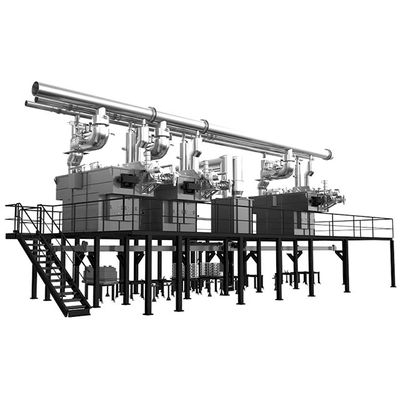


ONEJOON - Lift Bottom Kilns
The lift bottom kiln ONEJOON is the ideal solution for processes with debinding steps and a very high demand placed on temperature homogeneity. It enables the fully automatic and controllable treatment of workpieces under different sequential atmospheric conditions and temperatures. This is of particular benefit to users who produce various product batches using different firing curves and atmospheres. The lift bottom kiln clearly demonstrates its advantages when the production capacity of each individual batch is too small for a continuous furnace. On the other hand it is possible to install several lift bottom kilns in one line, which are fed by a common conveyor system. This leads to a high degree of flexibility and helps to optimise production planning. The floor loading concept thus enables extremely compact plant layouts.
With ONEJOON Lift Bottom Kilns different processes can be mapped.
These include, for example:
- debinding
- sintering
- calcination
- cooling
The correct heat treatment of high-performance ceramics
The fill structure loaded with the products to be manufactured is transported to the furnace floor and lifted upwards via a lifting portal. As soon as the floor has reached its position under the furnace, both are locked together. To prevent heat from escaping and, at the same time, ensure a gas-tight seal, a floating seal with spring-loaded elements is used. The lifting portal is then used for loading and unloading other parallel furnaces.
During the debinding phase (up to 500 °C), the furnace load is heated by circulating hot air, which has previously been preheated by an external heater. The waste gas contaminated with the binder is cleaned in a thermal afterburning
plant. At the end of the debinding phase, further heating is carried out by electrical heating elements in the furnace.
The process gas can also be kept in circulation at elevated temperatures up to 800 °C. This contributes to optimum temperature homogeneity during the heating process. The circulation of the process gas ends at temperatures above 800 °C.
Also in the subsequent process steps, no gas or air circulation takes place until the maximum temperature is reached. This is because turbulence in the furnace atmosphere is often very critical for sintering and crystallisation processes. At the end of the process, the workpieces are cooled with tempered air or gas. For this purpose, an external heating system regulates the temperature of the cooling medium in advance before it reaches the product carriers
and the products. After cooling down to approx. 250 °C, the furnace floor is transferred from the lifting portal to a cooling chamber where the products are finally cooled down to room temperature.
- excellent temperature homogeneity
- optimised cycle times
- low spatial requirement, compact layout
- flexible production planning
- easily scalable
- maximum energy efficiency
- very high heating rates
- highest temperature homogeneity
- process gas circulation up to 800 °C
- high-temperature sintering up to 1650 °C
- gas or electric heating
- furnace bottom spring seal
- SiC airflow blinds
- preheated circulating air
- additional final cooling chamber
- safety concept with emergency N2 flushing system
- CFD simulation to optimise the air flow
